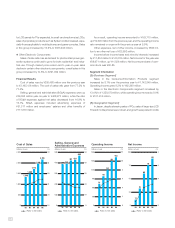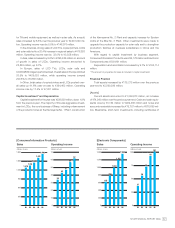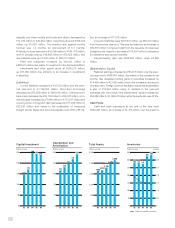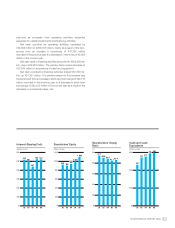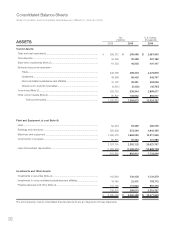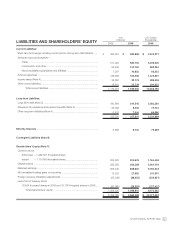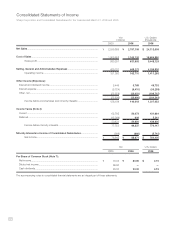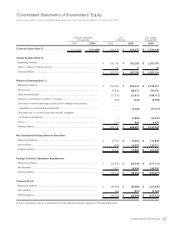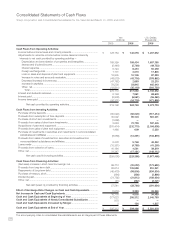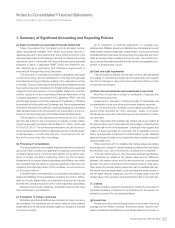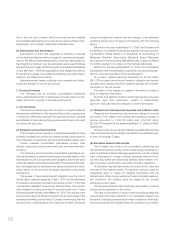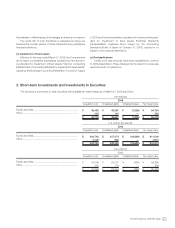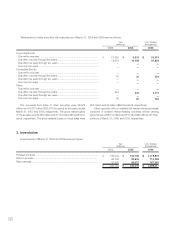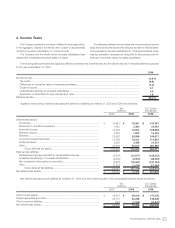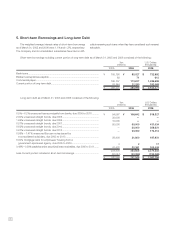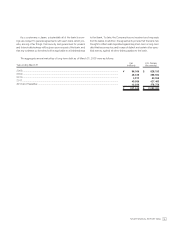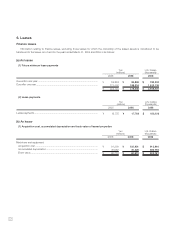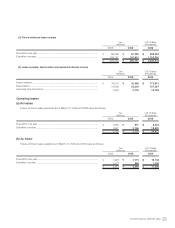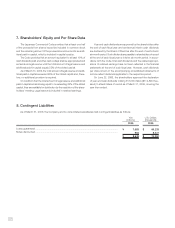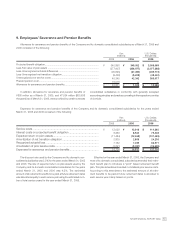Sharp 2006 Annual Report Download - page 41
Download and view the complete annual report
Please find page 41 of the 2006 Sharp annual report below. You can navigate through the pages in the report by either clicking on the pages listed below, or by using the keyword search tool below to find specific information within the annual report.
SHARP ANNUAL REPORT 2006 40
(a) Basis of presenting consolidated financial statements
Sharp Corporation (the “Company”) and its domestic consoli-
dated subsidiaries maintain their official accounting records in
Japanese yen and in accordance with the provisions set forth in the
Japanese Securities and Exchange Law and its related accounting
regulations, and in conformity with accounting principles generally
accepted in Japan, (“Japanese GAAP”) which are different in cer-
tain respects as to application and disclosure requirements of
International Financial Reporting Standards.
The accounts of overseas consolidated subsidiaries are based
on their accounting records maintained in conformity with generally
accepted accounting principles prevailing in the respective countries
of domicile. The accompanying consolidated financial statements have
been restructured and translated into English (with some expanded
descriptions and the inclusion of consolidated statements of share-
holders’ equity) from the consolidated financial statements of the
Company prepared in accordance with Japanese GAAP and filed
with the appropriate Local Finance Bureau of the Ministry of Finance
as required by the Securities and Exchange Law. Some supplementary
information included in the statutory Japanese language consolidated
financial statements, but not required for fair presentation, is not pre-
sented in the accompanying consolidated financial statements.
The translations of the Japanese yen amounts into U.S. dollars
are included solely for the convenience of readers outside Japan,
using the prevailing exchange rate at March 31, 2006, which was
¥116 to U.S. $1.00. The convenience translations should not be con-
strued as representations that the Japanese yen amounts have been,
could have been, or could in the future be, converted into U.S. dol-
lars at this or any other rate of exchange.
(b) Principles of consolidation
The accompanying consolidated financial statements include the
accounts of the Company and significant companies over which the
Company has power of control through majority voting right or exis-
tence of certain conditions evidencing control by the Company.
Investments in nonconsolidated subsidiaries and affiliates over which
the Company has the ability to exercise significant influence over
operating and financial policies of the investees, are accounted for
on the equity method.
In the elimination of investments in consolidated subsidiaries, the
assets and liabilities of the subsidiaries, including the portion attribu-
table to minority shareholders, are evaluated using the fair value at
the time the Company acquired control of the respective subsidiaries.
Material intercompany balances, transactions and profits have
been eliminated in consolidation.
(c) Translation of foreign currencies
Monetary assets and liabilities denominated in foreign currency
are translated into Japanese yen at current rates at each balance
sheet date and the resulting translation gains or losses are charged
to income currently.
As to translation of financial statements of overseas sub-
sidiaries and affiliates, assets and liabilities are translated at current
rates at each balance sheet date, shareholders’ equity accounts are
translated at historical rates, and revenues and expenses are trans-
lated at average rates prevailing during the year. The resulting for-
eign currency translation adjustments are shown as a separate com-
ponent of shareholders’ equity.
(d) Cash and cash equivalents
Cash and cash equivalents include cash on hand, deposits placed
with banks on demand and highly liquid investments with insignifi-
cant risk of changes in value which have maturities of three months
or less when purchased.
(e) Short-term investments and investments in securities
Short-term investments consist of certificates of deposits and
interest-bearing securities.
Investments in securities consist principally of marketable and
nonmarketable equity securities and interest-bearing securities.
The Company and its domestic consolidated subsidiaries cat-
egorize those securities as “other securities”, which, in principle,
include all securities other than trading securities and held-to-matu-
rity securities.
Other securities with available fair market values are stated at
fair market value which is calculated as the average of market prices
during the last month of the fiscal year. Unrealized holding gains and
losses on these securities are reported, net of applicable income
taxes, as a separate component of shareholders’ equity. Realized
gains and losses on sales of such securities are principally computed
using average cost.
Other securities with no available fair market values are stated
at average cost, except for interest-bearing securities which are stated
at amortized cost, net of the amount considered not collectible.
If the fair market value of other securities declines significantly,
such securities are stated at fair market value and the difference
between fair market values and the carrying amount is recognized
as loss in the period of decline. If the net asset value of other secu-
rities, except for interest-bearing securities, with no available fair mar-
ket values declines significantly, such securities are written down to
the net asset value by charging to income. In these cases, such fair
market value or the net asset value is carried forward to the next year.
( f ) Leases
Finance leases, except those leases for which the ownership of
the leased assets is considered to be transferred to the lessee, are
primarily accounted for as operating leases.
(g) Inventories
Finished products are principally stated at the lower of moving
average cost or market, however, finished products held by over-
seas consolidated subsidiaries are principally valued at the lower of
1. Summary of Significant Accounting and Reporting Policies
Notes to Consolidated Financial Statements
Sharp Corporation and Consolidated Subsidiaries



